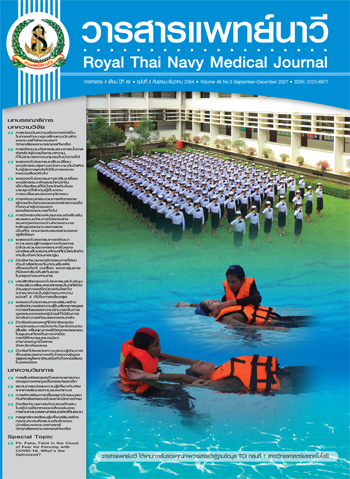Predicting Factors for Pre-exposure Prophylaxis (PrEP) Taking-behaviors Among Men Who Have Sex with Men (MSM) in Bangkok Metropolis
Main Article Content
Abstract
This cross-sectional study aimed to study predicting factors for pre-exposure prophylaxis (PrEP) taking-behaviors among men who have sex with men (MSM) among aged over 18 years old who received PrEP in Bangkok metropolis. The study applied PRECEDE-PROCEED model as a conceptual framework. The snowball sampling technique was employed with all 337 male. Data was collected by using online questionnaires (google form) conducted between July-August 2020. Analyzing used descriptive statistics and stepwise multiple regression analysis.
The results showed that the majority of the samples had 75.1% of PrEP taking-behaviors at a good level. Predicting factors for PrEP taking-behaviors among MSM at 44.8% (R2 = .448, p < .05) there were five variables from descending prediction weight: social stigma (β = 0.497), PrEP usage attitude (β = 0.317), HIV risk behaviors (β = 0.109), age and health service system access (β = 0.087).
The results used to promote accessibility to health service system for MSM, promote positive PrEP usage attitude especially among young MSM with HIV risk behaviors. In addition, the understanding of PrEP should be strengthened to the general public to reduce stigmatization in PrEP users.
Article Details

This work is licensed under a Creative Commons Attribution-NonCommercial-NoDerivatives 4.0 International License.
References
Health Department; AIDS, TB and STIs Control Division. Estimating the situation of the HIV / AIDS epidemic in Bangkok 2018 - 2030. Bangkok: AIDS, TB and STIs Control Division; 2019. (in Thai).
Buapan C, Rutchanagul P, Buaboon N. Factors predicting condom use behavior among MSM in Bangkok. Journal of Boromarajonani College of Nursing. Bangkok. 2561;34(2):62-73. (in Thai).
Department of disease control; Bureau of AIDS, TB, and STIs. National sexually transmitted disease prevention and control strategy 2017 - 2021. Bangkok: Aksorn Graphic and Design Publishing; 2016. (in Thai).
Anderson PL, Glidden DV, Liu A, Buchbinder S, Lama JR, Guanira JV, et al. Emtricitabine-tenofovir concentrations and pre-exposure prophylaxis efficacy in men who have sex with men. Sci Transl Med 2012 Sep 12;4(151):151ra125. doi: 10.1126/scitranslmed.3004006.
Department of Disease Control; Bureau of AIDS, TB and STIs. Thailand national guideline on Pre-Exoosure prophylaxis HIV-PrEP 2018. Bangkok: Aksorn Graphic and Design Publishing; 2018. (in Thai).
Vasantiuppapokakorn M. Workshop document for monitoring the progress of Index Testing & PrEP: directions of HIV infection prevention in Thailand, March 2-4, 2020. [Internet]. [cited 24 November 2020]. Available from: http://www.prepthai.net/ ViewDocument Detail.aspx? Id = 557. (in Thai).
World Health Organization. Implementation tool for pre-exposure prophylaxis (PrEP) of HIV infection. Module 1: Clinical and Module 11: PrEP Users. [Internet]. [cited 2019 October 1]. Available from: https://www.who.int/hiv/pub/prep/prep-implementation-tool/en/.
Department of Disease Control; Bureau of AIDS, TB and STIs. Thailand national guideline on Pre-Exoosure prophylaxis HIV-PrEP 2018. Bangkok: Aksorn Graphic and Design Publishing; 2018. (in Thai).
Hoagland B, Moreira RI, De Boni RB, Kallas EG, Madruga JV, Vasconcelos R, et al. High pre-exposure prophylaxis uptake and early adherence among men who have sex with men and transgender women at risk for HIV infection: the PrEP Brasil demonstration project. Journal of the International AIDS Society 2017;20(1):1-14.
Wheeler DP, Fields SD, Beauchamp G, Chen YQ, Emel LM, Hightow‐Weidman L, et al. Pre‐exposure prophylaxis initiation and adherence among Black men who have sex with men (MSM) in three US cities: results from the HPTN 073 study. J Int AIDS Soc 2019 Feb;22(2):e25223. doi: 10.1002/jia2.25223.
Koenig JL, Lyles C, Smith DK. Adherence to antiretroviral medications for HIV pre-exposure prophylaxis lessons learned from trials and treatment studies. American Journal of Preventive Medicine 2014;44(1S2):91-8.
Blashill AJ, Ehlinger PP, Mayer KH, Safren SA. Optimizing adherence to preexposure and post-exposure prophylaxis: the need for an integrated biobehavioral approach. Clinical Infectious Diseases 2015;60(S3):187-90.
Grov C, Rendina HJ, John SA, Parsons JT. Determining the roles that club drugs, marijuana, and heavy drinking play in PrEP medication adherence among gay and bisexual men: implications for treatment and research. AIDS and Behavior 2018;23(5):1277-86.
Sidebottom D, Ekström AM, Strömdahl S. A systematic review of adherence to oral pre-exposure prophylaxis for HIV–how can we improve uptake and adherence. BMC Infectious Diseases 2018;18(581):1-14.
Holloway I, Dougherty R, Gildner J, Beougher SC, Pulsipher C, Montoya JA, et al. PrEP uptake, adherence, and discontinuation among California YMSM using geosocial networking applications. HHS Public Access 2017;71(1):15-20.
TIWARI C. Factors associated with Pre-Exposure Prophylaxis (PrEP) adherence self-efficacy among high-risk drug users in treatment. [Internet]. [cited 2019 July 10]. Available from: https://opencommons.uconn.edu/gs_theses/ 1149.
Wood S, Gross R, Shea JA, Bauermeister JA, Franklin J, Petsis D, et al. Barriers and facilitators of PrEP adherence for young men and transgender women of color. AIDS and Behavior 2019;23(10):2719-29.
Haberer JE. Current concepts for PrEP adherence: in the PrEP revolution; from clinical trials to routine practice. Current Opinion in HIV and AIDS 2016;11(1):10-7.
Golub SA, Gamarel KE, Rendina HJ, Surace A, Lelutiu-Weinberger CL. From efficacy to effectiveness: facilitators and barriers to PrEP acceptability and motivations for adherence among MSM and transgender women in New York city. AIDS PATIENT CARE and STDs 2013;27(4):248-54.
Seekaew P, Nguyen E, Sungsing T, Jantarapakde J, Pengnonyang S, Trachunthong D. et al. Correlates of nonadherence to key population-led HIV pre-exposure prophylaxis services among Thai men who have sex with men and transgender women. BMC Public Health 2019;19:328. doi: 10.1186/s12889-019-6645-0.
Green LW, Kreuter MW. Health program planning: an education and ecological approach. 4th ed. New York: McGraw-Hill Companies; 2005.
Department of Disease Control, Bureau of AIDS, TB and STIs. Results of HIV surveillance in Bangkok, 2018. Nonthaburi: Thanapornpanich; 2019. (in Thai).
Department of Disease Control: Bureau of AIDS, TB and STIs. HIV risk assessment guide. [Internet]. [cited 2019 December 20]. Available from: http://www.bangkok.go.th/aids. (in Thai).
Desai M, Field N, Grant R, McCormack S. State of art review: recent advances in PrEP for HIV. BMJ 2018;359(j5011):1-34.
Hirandit A. Pharmacotherapy for HIV/AIDS patients. In: Sonthisombat P, Montalantikul P, editor. Handbook for hospital pharmacy. 3rd ed. Bangkok: Association of Hospital Pharmacy; 2012. (in Thai).
Ajzen I. Attitude, personality, and behavior. Chicaco, IL: Dorsey Press; 1988.


